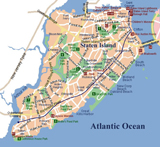
Brooklyn had Walt Whitman to sing its praises. Manhattan had Woody Allen to defend its neurosis. Staten Island? Well, Staten Island was where misbehaving cops were sent to as a punishment. There, in the uneventful streets of this eminently residential area southwest of Manhattan, he could ponder the error of his ways.
If you compare this to the arson-laden streets of The Bronx and the Mafia-ran streets of Manhattan, you will understand the fascinating contradiction that is Staten Island.
America has very little to do with New York. In fact, when the Civil War broke out -- which was the most critical moment in the history of the U.S. -- the state seriously considered proclaiming themselves an independent Republic to monopolize trade between the North and the South. They only gave up on the idea when the South imposed extremely high duties. Only then did they reluctantly take arms.
Things have changed very little since then. But this doesn't mean New York is not part of America. And the differences between that country and this city do not generally lead to conflict. This is in part because there is a link between America and New York -- it is called Staten Island.

Staten Island is only a part of New York because geography so dictated. It doesn't meet any of the characteristics that make the rest of the boroughs belong to New York City.
Rather, Staten Island stands as its very own, very American thing -- a residential area of middle-class suburbian tranquility, where the streets that follow the foot trails of the Hackensack and Raritan Indians are tread on by the high heels girls wear to go to the supermarket.
Staten Island would fit right among those quiet, introspective American cities where sense of community is strong, where opinions are shared and where pride in smaller things is taken (if talk to a Staten Island local and ask about what's so interesting about it, you will be pointed out repeatedly that, of the five boroughs, only Staten Island has a county fair with bed races and ribbons for the worthiest zucchini).
It may even be better off not belonging to New York City. That's the general belief of its inhabitants, at least. But then again, they are major secessionists. They keep voting on whether or not to secede. Their last vote was on 1994, but state senators have never completely abandoned the idea.
By upgrading from Staten Island would be the second biggest city in New England. And maybe it would stop receiving all the things that New York doesn't want -- yellow-fever patients in the 19th century, the nation's largest daily allotment of garbage, prisons and homeless centers.
It would, however, be a shame. Staten Island is a wonderful addition to New York's collection of curious facts and colorful people. It just manages to take normal situations and condiment them with a touch of weird. It has seen its own wars start -- over the theft of pigs and the trade of whisky. It has seen native Americans killed on its soil -- particularly a girl that was picking peaches in the Attorney General's orchard before he blasted her dead.
It has however seen some of its locals rise to fame -- namely, the first Catholic saint born in America, a Gambino family underboss and Steven Seagal. Ulysses S. Grant was close to living there as well, but his wife opined there were too many mosquitoes.
Still, there are things to be seen and done in Staten Island. You have the fantastic view from Fort Wadsworth. Across New York Harbor, you can see Manhattan rising with its intimating blue-and-gray-colored look. If you look to the right, you can almost make out the exact point where Manhattan ends and Brooklyn begins. The same can be said about New Jersey to the left. It's a unique perspective.
But, no matter how much the most chauvinist Manhhanitine may hate hearing this, there are other things to do in Staten Island that don't have anything to do with New York City more than Staten Island itself. Sure, there are no movies made or books written or songs composed about them (although there was a film called Staten Island. The Movie about "junior gangsters, guidos, preps, rockers, homeboys and other assorted dregs of humanity in scenic Staten Island, the largest garbage dump in the world"), but Fort Wadsworth is, into itself, a fine monument to behold.
There's also the Conference House, where the British secretly met with some Founding Fathers to negotiate a peace.